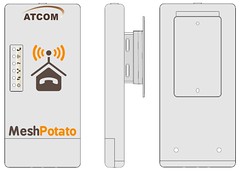 This is a big moment for the Village Telco. We have finally arrived at the of the journey that began in June 2008 when I sat down with some very, very bright and innovative people and together we decided not to re-purpose rich world technology for Africa but to boldly design our tech to meet our own requirements. Don’t get me wrong, if something vaguely similar had already existed we would have jumped at it but at the time no one was manufacturing a mashed up WiFi AP and Analogue Telephony Adaptor. They still aren’t.
This is a big moment for the Village Telco. We have finally arrived at the of the journey that began in June 2008 when I sat down with some very, very bright and innovative people and together we decided not to re-purpose rich world technology for Africa but to boldly design our tech to meet our own requirements. Don’t get me wrong, if something vaguely similar had already existed we would have jumped at it but at the time no one was manufacturing a mashed up WiFi AP and Analogue Telephony Adaptor. They still aren’t.
You can see the final design of the Mesh Potato at the right. Those of you are familiar with the Ubiquiti Nanostation II will know that we borrowed wholesale from their excellent enclosure design. They say imitation is the sincerest form of flattery. In this case, it is certainly true. We love Ubiquiti gear.
What we’ve borrowed from Ubiquiti is the sealed-unit design which makes for a sturdy weather-proof enclosure. What’s a little bit different is the back mounting which has a slip-on piece that can be screwed to a wall. Without the screw-on piece there is a similar mounting to the Nanostation for mounting on a pole.
 The best news of all is that Mesh Potatoes are now available for purchase by anyone. Simply click on the Products link above to buy them from our webstore. The cost of each Mesh Potato is USD 119 but for the next two weeks we’re making them available at the wholesale price of USD 89 per unit. In order get that price, enter “afinemesh” as a coupon code on the Checkout page after you have selected the number of Mesh Potatoes that you’d like. Shipping is calculated via DHL from Atcom in China. Please contact us if you’d like to make other shipping arrangements. Orders placed now will ship by the end of September.
The best news of all is that Mesh Potatoes are now available for purchase by anyone. Simply click on the Products link above to buy them from our webstore. The cost of each Mesh Potato is USD 119 but for the next two weeks we’re making them available at the wholesale price of USD 89 per unit. In order get that price, enter “afinemesh” as a coupon code on the Checkout page after you have selected the number of Mesh Potatoes that you’d like. Shipping is calculated via DHL from Atcom in China. Please contact us if you’d like to make other shipping arrangements. Orders placed now will ship by the end of September.
Finally, I would just like to express ongoing amazement and appreciation of the many, many people who have contributed to making the Mesh Potato a reality in small ways and in big earth-shaking ways. You know who you are. You all seriously rock. Open Software, Open Hardware refreshes the parts that other intellectual property regimes can’t reach. Thank you.